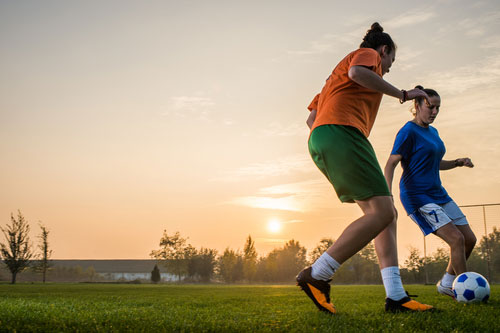 Fall sports are getting into gear, and it’s a blast! For football lovers, it’s heaven. Soccer lovers are enjoying the break from the heat. Tournaments, schedules and teams are all aligning to form a big part of many people’s lives. Here are the common injuries to look out for, and some ways to stay healthy.
Fall sports are getting into gear, and it’s a blast! For football lovers, it’s heaven. Soccer lovers are enjoying the break from the heat. Tournaments, schedules and teams are all aligning to form a big part of many people’s lives. Here are the common injuries to look out for, and some ways to stay healthy.
Tennis Elbow
A significant percentage of sports injuries are elbow injuries. Tennis elbow doesn’t just occur in tennis. Repetitive use of the elbow in any sport can create small tears in the elbow’s ligaments, leading to pain and inflammation over time. This condition usually occurs in those 30-60 years of age. If you begin to feel consistent pain the elbow, rest, ice and anti-inflammatory medication is often the best remedy. To prevent this condition, try doing exercises that strengthen the forearm. Elbow braces can also be effective.
Shoulder Injury
The shoulder is a complex joint, which is why it’s important to properly take care of it when playing sports. Dislocations, sprains and simple strains are very common. Swimming, tennis, basketball and volleyball are all sports that can put a lot of strain on the shoulder, because of the arm movement over the head. In football, tackles often result in hard impact directly on the shoulder. If ice, rest and anti-inflammatory medication don’t result in improvements in shoulder pain, it’s time to see an orthopedic specialist.
Knee Injuries
It’s estimated that about half of all sports injuries are knee injuries. It’s easy to see why, as football tackles are often at knee level, and soccer slide tackles are also at knee level. Many collisions in these sports often occur at awkward angles, with the athlete not expecting it. Even if it isn’t a traumatic injury, knees can sometimes just wear out. When the kneecap repeatedly moves against the leg bone, knee tissue becomes damaged and causes pain, called Patellofemoral Syndrome. Cycling, swimming, volleyball and running can all cause this kind of knee issue. If you are beginning to experience regular knee pain, it’s times to move toward less intense, low impact exercise. Also, invest in shoes that fit properly, and that offer the correct support. Avoid concrete, and exercise on grass or softer track surfaces. Other common conditions to watch out for: • Shin Splints • Sciatica • Hamstring Strain If You’re Already Injured, and Things Aren’t Getting Better… Don’t worry! There are a variety of effective options for people who’ve been injured playing fall sports like football, basketball, soccer or tennis. Many options are minimally invasive, meaning that treatment is less traumatic, and recovery is faster. Even joint replacement is less invasive now than ever before, with better results. The orthopedic surgeons and sports medicine professionals at West Idaho Orthopedics are highly experienced and able to treat the bread spectrum of fall sports injuries.